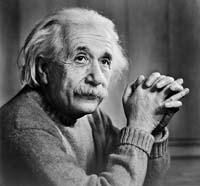Reality, Zeilinger and current physics

The moon is in the sky. We see it. But does it also exist when no one sees it? This question is not simple. We know that the Moon exists when we see or measure the consequences of existing. Because we cannot perceive the Moon otherwise. But we cannot say that the Moon exists if it is not seen or measured at the moment. And you can't say that the Moon is there when we don't see it or measure it. So what is the Moon? The Moon is the same information.
Therefore, reality is information. When we don't have information, we assume what reality is, but we can't take it for granted. The Moon will be in space, yes.
Modern physics
Beyond this simple argument, physicists were in the 20th century. in the first half of the 20th century. According to them, the Moon does not exist if we do not see it or measure it. It is not known whether it exists or not, but it does not exist. Later, when we see it, it exists.
Albert Einstein was very concerned about this question, how will the Moon not exist when we do not see it? When we talk about the Moon, the approach seems a nonsense, but it is not clear what happens if we talk about electrons and protons.
We understand electrons, protons and particles of this type through the laws of quantum mechanics, we cannot understand them with the classical principles of physics. And there is the question: applying these laws, an electron does not measure a physical characteristic until we measure it. It is not an idea according to instinct and, however, it happens.

Where is an electron? To answer this question we must measure where it is. Moreover, according to quantum physics, while we do not measure it, the electron is nowhere. We don’t know where it is… it’s nowhere! And if this idea works with electrons and protons, why not with the Moon? The Moon is only a set of electrons, protons and other particles. Einstein understood this whole argument, but he could not accept it. He did not accept the interpretation that quantum physicists gave to reality.
Basic questions
Anton Zeilinger, an heir to those physicists, favors such discussions, believes that physics should be a science that asks what reality is. "That was the big challenge until modern physics developed. Galileo and Newton stopped wondering why. They stopped looking for the essence of phenomena. For example, they didn't want to know why a stone falls. Or what is mass. They stopped asking these kinds of things. They only wanted a mathematical description of what happens. And that's the greatest success of modern science," says Zeilinger.
Despite the success of modern science, the merit is not to ask these questions for the first time, but to take them back. This is, in short, the questions posed by the Greek philosophers. "These are very philosophical questions," says Zeilinger, "and modern physics can find answers within a hundred years and perhaps within five hundred years. In any case, they are questions of the future."
Inertia
Richard Feynman received the 1965 Nobel Prize in Physics, with the same approach as the basic questions. For example, What Do You Care What Other People Think? in the book (What matters to you? ), Feynman says that as a child he had a truck and a ball to play. When the ball was placed inside the truck and driving the truck, the ball moved back. Advance in braking. "Why is this happening?" asked his father the young Feynman. "No one knows," the father said, "we call ourselves inertia, but no one knows why."

Inertia is studied, because what we call Newton's first law today is the physical law of inertia. If a force does not act, an object does not change speed. If it is standing, it will stand and if it is moving it will continue to move with the same speed and in the same direction and direction. Of course. It is a universal law of nature. But why nature plays like this… nobody knows.
According to Zeilinger, Feynman insisted on this idea. "In his opinion, philosophical questions are of great importance. Other physicists believe it is better to make calculations and not wonder what philosophical meaning the calculated one has, but Feynman disagreed. Philosophical questions had to be consulted, although perhaps we cannot answer."
Perception
Zeiliger has also taken care of these basic questions. "The main question is whether it is possible to distinguish between reality and information. I think you can't. When I talk about reality, when I talk about you, for example, I mean the information I have about you. I collect all the information I have about you in my brain, form an image and incorporate it into your reality. But this image is based on information. This idea is very important."
However, this approach poses many problems. Looking at the same thing, two people see different things, that is, they receive different information. In short, limitation is perception.
We see it. We listen. We play, smell, etc. and so is the perception of the world. But we never know to what extent the senses are reliable. In addition, it is not just a sensory problem.

The perception of time, for example, does not depend on what a sense perceives. It is another thing, an interpretation of the brain. A certain time, like a year, is not as perceived by a child as by an adult. For the child it is usually a very long year and for the adult not. But how much is actually a year?
Many insects have a one-year life cycle in which they are born, develop, reproduce and die. A year for the insect is all life, and probably the perception of that period is not like that of a human being.
Fast and slowly
This perception is very important, for example, for reptiles. They are cold blood and their metabolism depends on temperature. They have a fast metabolism when there is heat and slow when there is cold. And metabolism influences movement; by day, under the sun, they are very fast animals, while at night they move slowly.
Hawks who feed on lizards take advantage of it, have little chance of catching them throughout the day, and for the hunt to be fruitful must strive at dawn or dusk. Falcon metabolism does not vary with room temperature, for them time is the same day and night. For Muskiz, on the contrary, the perception of time would vary greatly: from his point of view, the hawk is very fast at dawn and dusk, while throughout the day it is slow.
Objective measurement

Since perception varies from living being to living being and from person to person, the only way is to use tools to have objectivity. Time, for example, can be measured through clocks and, although we have the perception we receive, we will have an objective time, a clock that serves everyone.
It is an interesting idea, but physically impossible. In fact, time is relative according to the theory developed by Einstein. Two things that occur at once do not occur simultaneously from all reference systems. Logically, this surprising gap proposed by Einstein occurs when reference systems are moving together and only detected near the speed of light. Man cannot move at that speed, so he does not perceive it, but it happens.
According to the theory of relativity, therefore, it cannot be an objective perception of time. According to quantum mechanics, the particle questions reality. The two main theories of modern physics predict that it is difficult to decide what reality is. In the end, asking if the Moon is real or not is not rare. The Moon is that information we receive by looking at the sky or measuring our satellite. In short, reality is pure information.

Buletina
Bidali zure helbide elektronikoa eta jaso asteroko buletina zure sarrera-ontzian











